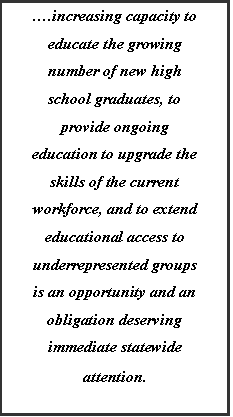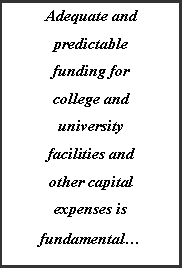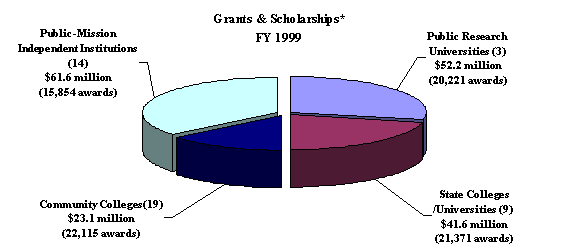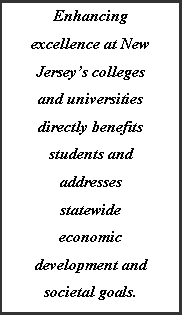HIGHER EDUCATION:
MEETING CHALLENGES OF THE FUTURE
ANNOTATED EXECUTIVE OVERVIEW
 New Jersey must strategically plan for the
future and aggressively invest in higher education to ensure the state’s
continued competitiveness, future prosperity, and societal well-being. Colleges
and universities prepare the human resources necessary to fuel economic growth,
sustain technological advantages, create new knowledge, improve education from
preschool to graduate school (P-20), and provide leadership for the future.
Nationally, the successful collaborative efforts of government, higher
education, and the private sector are setting states apart as leaders in the
new economy. New Jersey also must assume a leadership role, building on its
abundance of human, geographical, commercial, and industrial assets through
investments in higher education and research that underlie economic competitiveness
and quality of life.
New Jersey must strategically plan for the
future and aggressively invest in higher education to ensure the state’s
continued competitiveness, future prosperity, and societal well-being. Colleges
and universities prepare the human resources necessary to fuel economic growth,
sustain technological advantages, create new knowledge, improve education from
preschool to graduate school (P-20), and provide leadership for the future.
Nationally, the successful collaborative efforts of government, higher
education, and the private sector are setting states apart as leaders in the
new economy. New Jersey also must assume a leadership role, building on its
abundance of human, geographical, commercial, and industrial assets through
investments in higher education and research that underlie economic competitiveness
and quality of life.
This year, the state appropriated approximately $1.9 billion to support a diverse, dynamic system of public
and independent colleges and universities that strives to meet student and state needs. However, the new technology-driven, knowledge-based economy and the changing demographics impose significantly greater demands on higher education in New Jersey and nationally – demands which must be met to maintain a prosperous society and economy (p.7).
The Commission on Higher Education and the New Jersey Presidents’ Council urge the state to significantly enhance short- and long-term investments in higher education by addressing three priority areas that will shape New Jersey’s future. The first is to increase capacity to meet higher education student needs and state workforce demands (p.8-15). The second is to assure access to high-quality, timely educational opportunities for all segments of the population (p.15-20). And the third is to promote excellence in P-20 education and academic research and development (p.20-23).
CAPACITY TO MEET STUDENT AND WORKFORCE NEEDS
Operating Aid. Additional state and county aid is essential for two primary reasons:
1) to avoid reliance on students to pay an increasingly larger share of college and university operational costs and 2) to augment human resources necessary to provide high-quality educational services to additional students.
 The Commission and the Presidents’ Council
recommend a continuation of the $12 million annual increases in state operating
aid for community colleges to
further balance the funding partnership and support increased capacity.
However, the increased aid should be matched by an increase in the level of
county aid. This commitment will move the state closer to the desired one-third
share of operating aid from the state, one-third from the counties, and
one-third from the students (p.10-11).
The Commission and the Presidents’ Council
recommend a continuation of the $12 million annual increases in state operating
aid for community colleges to
further balance the funding partnership and support increased capacity.
However, the increased aid should be matched by an increase in the level of
county aid. This commitment will move the state closer to the desired one-third
share of operating aid from the state, one-third from the counties, and
one-third from the students (p.10-11).
A 10.5 percent increase in operating aid is recommended for senior public institutions to begin moving the state toward the desired two-thirds share of operating costs and to promote affordability and academic quality of the four-year public institutions. An estimated $65 million (7.0%) increase is necessary to cover required salary increments and COLAs. An additional $31.4 million (3.5%) is recommended to cover general inflationary costs and assist with improvement efforts. (p.11-12).
The Commission and the Presidents’ Council also recommend an increased appropriation for the New Jersey Independent College and University Assistance Act, recognizing the major contribution of the 14 independent colleges and universities in educating New Jersey residents. An increase of $3 million is recommended for FY 2003, with an additional $3 million increase in FY 2004 to achieve the statutorily prescribed funding level (p.12-13).
Capital Resources and Support. A fall 2001 higher education capital planning report prepared by the Commission and the Presidents’ Council provides comprehensive data regarding demographic trends and long-term projections of capital needs. The report is designed to inform state policymakers as they determine in the next legislative session how New Jersey will support capital needs and expanded higher education services in coming years in response to burgeoning student demand and related state needs. In the interim, the Commission and the Presidents’ Council recommend a general appropriation of $72.6 million in FY 2003 for maintenance and renewal at the senior public institutions to assist in preserving the physical plant (p.13-15).
ACCESS TO HIGH-QUALITY EDUCATION FOR ALL
Intensified efforts are necessary to expand access to higher education and the opportunities it offers to equip all segments of the population with the skills and knowledge needed to succeed. College and university efforts should extend beyond postsecondary students to increased institutional involvement in school reform and precollegiate programs.

Educational Opportunity Fund (EOF). The Commission and the Presidents’ Council recommend an additional $2.7 million in state funding to strengthen the capacity of campus EOF student services that support improvements in retention, transfer, and graduation rates of disadvantaged students. The state increase in Article IV funding, which supports these services, continues to be the top priority of the EOF Board of Directors. A $1.5 million increase in Article III academic year student grants is also important given that some students and their families continue to face extraordinary costs relative to their incomes, even when state and federal grants are considered (p.17-18).
Tuition Aid Grants (TAG). The Commission and the Presidents’ Council support the Higher Education Student Assistance Authority (HESAA) Board’s recommendation that TAG awards, the state’s primary need-based aid program, be increased to the maximum current year tuition levels for full-time students. The Commission and the Presidents’ Council also recommend $11 million to initiate a TAG program for part-time students, without limiting funds for those who attend full-time (p.18).
 College
Bound. The Commission and the
President’s Council recommend an increase of $2.1 million for the College Bound
program, which provides for hundreds of New Jersey’s disadvantaged youth to
enter college each year with skills in math, science, and technology. The
program exemplifies the power that collaborative P-20 efforts can have on
students’ lives. College Bound, which specifically targets the segments of the
population that the state must prepare for the future, has had no increase in
funding for 11 years (p.19-20).
College
Bound. The Commission and the
President’s Council recommend an increase of $2.1 million for the College Bound
program, which provides for hundreds of New Jersey’s disadvantaged youth to
enter college each year with skills in math, science, and technology. The
program exemplifies the power that collaborative P-20 efforts can have on
students’ lives. College Bound, which specifically targets the segments of the
population that the state must prepare for the future, has had no increase in
funding for 11 years (p.19-20).
COMMITMENT TO EDUCATIONAL EXCELLENCE
Deliberate planning and bold efforts are necessary to advance the state’s prosperity and competitiveness in the world economy. Targeted programs at New Jersey’s colleges and universities are central to impacting prekindergarten to grade 12 education, workforce demands, and research and development.
Teacher Effectiveness and Student Achievement. Recognizing that the quality of the teacher is the single most important school-based factor in student achievement, efforts to improve teacher effectiveness must be expanded. The Commission and the Presidents’ Council recommend $3 million to renew Teacher Effectiveness Grants that will build on existing programs renowned for their success in improving the effectiveness of practicing teachers (p.20-21).
High-Tech Workforce Excellence Grants. The Commission and the Presidents’ Council recommend continuation of the $15 million High-Tech Workforce Excellence Grant program. This initiative builds on highly successful programs to create a pipeline of skilled graduates to meet workforce needs. A third round of grants in FY 2003 would target specific shortage areas and include a capacity-building component for public colleges and universities in future years (p.21-22).
Increasing Capacity for Research and Development (R&D). Academic and corporate research is instrumental in creating new businesses and jobs, spawning new industries, improving productivity, and creating new knowledge. The Commission and the Presidents’ Council recommend a restoration of the full $10 million for the Biomedical and Other Technology Research Fund to assist in increasing external research dollars and building the much needed academic research and development capacity to complement and support the state’s extensive private sector R&D (p.22-23).
PRÉCIS
 New Jersey is faced with a consequential
policy decision as to whether and to what degree it will invest in higher
education to address growing demands and promote the state’s economic
development and prosperity. Higher education in itself, and in its
complementary relationship with elementary and secondary schools, embodies the
essential factors of a society that is not only economically sound, but a
society that relies on its citizenry to promote a culture of mutual respect and
understanding of America’s place in the world.
New Jersey is faced with a consequential
policy decision as to whether and to what degree it will invest in higher
education to address growing demands and promote the state’s economic
development and prosperity. Higher education in itself, and in its
complementary relationship with elementary and secondary schools, embodies the
essential factors of a society that is not only economically sound, but a
society that relies on its citizenry to promote a culture of mutual respect and
understanding of America’s place in the world.
This FY 2003 budget policy statement calls for a significant additional investment in higher education – an investment that is vital to New Jersey’s future citizenry and its prosperity in the knowledge-based, global economy. The recommendations summarized above are supported in the following pages with data and rationale from both a state and national context. Investments in higher education are no longer discretionary; they are imperatives for the improvement of education from P-20 and for ensuring tomorrow’s future.
HIGHER EDUCATION:
MEETING CHALLENGES OF THE FUTURE
THE NATIONAL CONTEXT
ECONOMY
Our global, knowledge-based and technology-driven economy continues to offer both challenges and opportunities for New Jersey and the nation. With intellectual capital and human resource development underpinning economic prosperity and quality of life, colleges and universities play an integral part in addressing those challenges and capitalizing on the opportunities.

Over the past year, the nation experienced a slowdown in the economy, which had realized dynamic growth and increasingly high rates of productivity from 1994 to 2000. The demands for global competitiveness and higher education’s role in meeting those demands remain crucial, despite periodic changes in the economy. States excel as a result of their ability to mobilize well-educated individuals and resources necessary to transfer innovations into new business strategies and commercial products. Regions and states that can produce, attract, and retain the best talent have a significant competitive advantage. Federal Reserve Board Chairman Alan Greenspan recently stated, “If we are to remain preeminent in transforming knowledge into economic value, the U.S. system of higher education must remain the world leader in generating scientific and technological breakthroughs and in preparing workers to meet the evolving demands for skilled labor.”
Human resource development is a critical requirement for economic development. Demand has greatly increased for a flexible educational system that integrates work and training and serves the broad academic needs of students, both those embarking on their careers as well as workers at various employment levels. Greater value is now placed by business and labor unions on training programs, ranging from welfare and school-to-work to corporate and higher education programs. At each educational level, the need exists for technologically advanced learning that is grounded in real-world curricula relevant to changing business needs.
America continues to make the transition to a technology-driven, information-based environment, but the demand for well-educated, high-skilled workers continues to exceed supply. In addition, an undeniable “digital divide” separates future workers into the technological “haves” and “have-nots.” Educators face the difficult task of preparing individuals of all ages and backgrounds with a strong general education and complex workforce skills, allowing them to participate fully in the new economy.
This charge falls, to a large degree, to higher education. Nationally, occupations that require a college degree are growing twice as fast as others. According to the U.S. Department of Labor, the earnings gap between college and high school graduates has grown from 38 percent in 1979 to over 70 percent today. While the fastest growing and highest paying jobs require a college degree, there are also existing and new jobs that require specific skills attainable through a certificate program and short-term training. The benefits of the new economy and educational opportunity beyond a high school diploma must be available to all, ensuring a well-prepared citizenry and skilled workforce necessary to maintain quality of life and the nation’s preeminence.
DEMOGRAPHICS
Rapidly changing demographics also present challenges and opportunities. The U.S. Department of Labor expects the national population to increase by 50 percent by 2050; ethnic minority groups will comprise nearly half the total population. Americans are living longer, spending less of their lives working, and having fewer children. At the same time, the senior segment of the population will more than double. As a result, Secretary of Labor Elaine Chao predicts an unprecedented labor shortage and an increasing number of retirees who will be dependent on fewer workers to support their entitlement programs.
The growth in population and a substantial growth in the number of school-age children intensify demands on colleges and universities, as does the need for lifelong learning to upgrade skills and prepare for multiple careers over a lifetime. The number of high school graduates nationally is expected to increase by almost 9 percent to reach 2.8 million by 2010. According to the U.S. Department of Education, in fall 2000 a record 15.1 million students were enrolled in college; 75 percent of the students attended public colleges. Between 2000 and 2010, full-time enrollment is projected to increase by 19 percent, and part-time enrollment is projected to increase by 11 percent nationwide. Both two- and four-year colleges anticipate increases, with two-year institutions expected to grow by 14 percent from 2000 to 2010 and four-year institutions expected to grow by 16 percent during the same time span. Undergraduate enrollment will rise approximately 16 percent from 13.1 million to 15.2 million students. Graduate enrollment is expected to increase by about 11 percent to 2.0 million, and first-professional enrollment is expected to rise 13 percent to about 0.3 million. These growth projections, along with the need for lifelong learning, have great implications for higher education and its capacity to meet national needs.
In New Jersey, which is among the most densely populated and diverse states in the nation, the already high population of Hispanics and African Americans, among other ethnic minority groups, is expected to continue to grow. While the state’s overall population is not expected to increase as much as many other parts of the nation, the projected growth in the number of high school graduates in New Jersey by 2008 is among the highest in the nation and will require increased higher education capacity. The state’s projected growth in the number of nontraditional students seeking higher education opportunities to meet workforce demands is also high.
ADDRESSING THE CHALLENGES IN NEW JERSEY
OVERVIEW
Colleges and universities are increasingly the focal point of global competition, and classrooms at all levels are precincts of global understanding, particularly in a state as diverse as New Jersey. The state’s institutions of higher education must recognize more than ever before that their unique position in society carries with it special and widespread responsibilities.
 New Jersey must aggressively address the
challenges of the future and seize opportunities to enhance technological
growth and economic prosperity through government and private sector
partnerships with higher education. Over the past several years, intense
competition has emerged among states to build higher education capacity and
excellence to meet the human resource development and research needs necessary
for an economic advantage in today’s global, information economy. New Jersey
should capitalize on its abundance of human, geographical, commercial, and
industrial assets and follow the lead of other states that have already
established higher education as a statewide priority and committed to major
investments. For example, North Carolina approved a $3.1 billion bond issue to
support higher education capital needs. Michigan recently committed $1 billion
for a multi-university “life science corridor” to promote biotechnology
research. Maryland committed to $1.23 billion over the next five years to meet
capital needs. And Pennsylvania is creating an Infrastructure for Sustainable
Innovation built around university clusters.
New Jersey must aggressively address the
challenges of the future and seize opportunities to enhance technological
growth and economic prosperity through government and private sector
partnerships with higher education. Over the past several years, intense
competition has emerged among states to build higher education capacity and
excellence to meet the human resource development and research needs necessary
for an economic advantage in today’s global, information economy. New Jersey
should capitalize on its abundance of human, geographical, commercial, and
industrial assets and follow the lead of other states that have already
established higher education as a statewide priority and committed to major
investments. For example, North Carolina approved a $3.1 billion bond issue to
support higher education capital needs. Michigan recently committed $1 billion
for a multi-university “life science corridor” to promote biotechnology
research. Maryland committed to $1.23 billion over the next five years to meet
capital needs. And Pennsylvania is creating an Infrastructure for Sustainable
Innovation built around university clusters.
Higher education’s vital role in establishing New Jersey as a leader in human and economic development hinges on several fundamentals, including: increased capacity to meet student needs and state workforce demands; access to high-quality, timely educational opportunities for all segments of the population; and a commitment to excellence in education and research and development. The state appropriated approximately $1.9 billion in FY 2002 to support a diverse, dynamic system of public and independent colleges and universities that strives to meet student and state needs. However, the new technology-driven, knowledge-based economy and the changing demographics impose significantly greater demands on higher education in New Jersey and nationally – demands which must be met to maintain societal well-being, economic prosperity, and global preeminence.
CAPACITY TO MEET STUDENT AND WORKFORCE NEEDS
College and university enrollment in New Jersey increased 164 percent since 1965, rising from 127,000 full- and part-time students to nearly 336,000 in 2000. More than one-third (124,000) of current students are enrolled in two-year community colleges. Over 142,000 students attend senior public institutions, with 63,000 at the three research universities and 79,000 at the nine state colleges and universities. About one-fifth (69,000) of the students attend independent colleges and universities, including 14 public-mission institutions, 3 proprietary institutions, and 8 theological institutions. Since 1965, graduate enrollment in New Jersey doubled from 25,000 to 51,000, undergraduate enrollment grew from 102,000 to 285,000, and part-time student enrollment grew from 58,000 to 142,000.
 Colleges and universities in the state are
committed to developing the full potential of New Jersey and its people. The
institutions strive to model tolerance and civility, celebrating the diversity
that creates rich learning environments. Most of the colleges and universities
in the state currently operate at or close to full capacityand are actively engaged in efforts to satisfy student demands by:
enhancing flexibility to serve students through nontraditional means;
incorporating technology and providing distance education; advancing
articulation and transfer and other means of collaboration among institutions;
and strengthening enrollment parity among all ethnic minority groups. Success
in each of these areas is necessary for efficient and effective accommodation
of a burgeoning demand for higher education to prepare individuals for
fulfilling lives, rewarding careers, and lifelong learning.
Colleges and universities in the state are
committed to developing the full potential of New Jersey and its people. The
institutions strive to model tolerance and civility, celebrating the diversity
that creates rich learning environments. Most of the colleges and universities
in the state currently operate at or close to full capacityand are actively engaged in efforts to satisfy student demands by:
enhancing flexibility to serve students through nontraditional means;
incorporating technology and providing distance education; advancing
articulation and transfer and other means of collaboration among institutions;
and strengthening enrollment parity among all ethnic minority groups. Success
in each of these areas is necessary for efficient and effective accommodation
of a burgeoning demand for higher education to prepare individuals for
fulfilling lives, rewarding careers, and lifelong learning.
However, New Jersey has historically maintained a relatively small system of higher education compared to other states, and 60 percent of the state’s recent high school graduates who attend four-year colleges and universities leave New Jersey. Reconsideration of that policy is now appropriate in light of changing demographics and economic demands.
As a result of the “baby boom echo” the number of high school graduates in New Jersey is projected to increase by approximately 19,000 between 2000 and 2008.
Based on current projections, if the annual percentage of high school graduates who attend college within 12 months of graduation remains constant and the same percentage of graduates attend college in New Jersey, the state should expect 6,770 more college freshmen in 2008 than were enrolled in 2001. The cumulative effect of the annual increase in freshmen is quite significant. Over the four-year period from 2005 to 2008, New Jersey colleges and universities would be serving an overall increase of over 22,000 more students than are currently served. Unlike the “baby boom,” which was followed by a significant decrease in students, the larger number of high school graduates in 2008 is projected to drop slightly and then level off. This significant and sustained increase in the number of high school graduates, as well as the increased number of non-traditional students in need of postsecondary education, necessitates augmented physical capacity and human resources at colleges and universities to serve more students and meet state workforce development needs.
The state’s colleges and universities must compete with the best in the nation if New Jersey is to prosper. Students require excellent faculty who are equipped with the latest technology and other resources to prepare them with a strong general education and the necessary skills for the rapidly changing workforce that fuels the economy. New Jersey policy makers, like those across the nation, are concerned about the shortage of skilled, technical workers with appropriate credentials. As a leading state in pharmaceuticals and telecommunications, New Jersey has a particularly widespread need for a highly skilled workforce.
The convergence of economic competitiveness, growing workforce demands, and demographic trends poses critical policy decisions for New Jersey. It is the Commission on Higher Education’s and the Presidents’ Council’s perspective that increasing capacity – to educate the growing number of new high school graduates, to provide ongoing education to upgrade the skills of the current workforce, and to extend educational access to underrepresented groups – is an opportunity and an obligation deserving immediate statewide attention and resources.
Two forms of support are essential for colleges and universities to educate growing numbers of new and returning students. General operating funds and capital support from state and local governments provide the foundation on which New Jersey’s 31 public institutions exist; the state also provides financial assistance to the 14 independent institutions with a public mission. The higher education community recently completed a systemwide capital planning report to help inform long-term planning and investments to sustain existing higher education capacity and expand physical plants and human resources as necessary to serve more students. The report, which will be updated annually, addresses all aspects of capital needs, ranging from new construction to equipment replacement over a period of seven years.
There is an immediate need, however, to increase operating support systemwide in FY 2003 to help meet the greatly intensified demand for high-quality, affordable higher education services. There is also an immediate need for state assistance to support maintenance and renewal of the state’s senior public institutions. Dealing with these immediate needs in FY 2003 is an important first step in addressing the larger capacity issue in New Jersey. In the future, as the system’s capacity is increased through expansion of physical plants and the enhanced use of distance education, concomitant increases in human resources also will be necessary. Specific recommendations for operating and capital support for the state’s colleges and universities in FY 2003 are based on the capital planning report and the goals of the long-range plan for higher education.
Operating Aid
Community Colleges. The long-range plan for higher education promotes increased operating aid for public institutions to balance the partnership between students and government. For the 19 community colleges, the plan calls for one-third of operating expenses to come from students, one-third from the counties, and one-third from the state. As a result of that recommendation, four consecutive years of enhanced state funding helped the community colleges limit tuition increases – several institutions froze tuition for consecutive years, and the average sector increase has ranged from 0.0 percent to 1.7 percent over a four-year period. The state share of operating expenditures increased from 24.8 percent in FY 1998 to an estimated 29.6 percent in FY 2001. (See chart below.) The FY 2002 state appropriation is approximately $155.7 million. Financial support from counties continues to vary, with some paying more than one-third and some paying much less. The average percentage contribution by counties has decreased, however, from 34 percent in FY 1995 to 30.6 percent in FY 2001. An additional $12 million increase in state operating aid for community colleges in FY 2003 will further balance the partnership and support increased capacity. This increased aid should be matched by an increase in the level of county aid.
SHARES OF OPERATING AID
Community Colleges
FY94 FY95 FY96 FY97 FY98 FY99 FY00 FY01
Tuition/fees 41.1% 42.0% 43.5% 43.7% 43.5% 42.5% 41.3% 39.8%
State 24.7% 24.0% 24.0% 23.7% 24.8% 26.3%* 28.0% 29.6%
County 34.3% 34.0% 32.4% 32.7% 31.7% 31.2% 30.7% 30.6%
*First year of $12 million annual increase in state funding
The minimal increases in community college tuition since FY 1999 provide the greatest benefit to the state’s most disadvantaged, low-income students. For them, access to higher education depends fundamentally on reasonable tuition levels, which better enable students to complete their degrees expeditiously and move into the workforce or a four-year college. In order to attain the desired parity in higher education, the state and county governments should balance the partnership to support existing capacity and meet increased operational costs necessary to meet growing demands for services.
The community colleges serve over one-third of the full- and part-time students enrolled in New Jersey colleges and universities. They are working collaboratively with four-year institutions to provide a seamless undergraduate education for baccalaureate degree seeking students and reduce overall tuition outlays. These colleges, which are conveniently located to serve students in every county, often represent the only route to higher education for underrepresented and disadvantaged students, as well as many adult returning students who seek to upgrade their professional skills.
Senior Public Institutions. The state’s 12 senior public colleges and universities enable students to contribute effectively to society and meet workforce needs. These 12 institutions are committed to addressing state needs through their individual, diverse missions.
The nine state colleges and universities have diverse missions but share the common goal of making high-quality higher education accessible and affordable. Collectively, their institutions educate a major portion of New Jersey’s citizens at the baccalaureate level, serving close to 80,000 students, of whom over 90 percent are state residents. These institutions also make an important contribution to the preparation of future leaders through graduate and professional education and to research, scholarship, and community service. Each of these institutions has a distinctive mission, encompassing a variety of emphases, such as science and technology; education and teacher preparation; service to urban populations; adult and continuing education; and undergraduate and graduate programs in the liberal arts, fine arts, and business disciplines. The nine state colleges and universities are committed to making higher education available to students, through cooperative relationships with state research universities, two-year colleges, the public schools, the military, the corporate sector, and local communities.
The state’s three public research universities include New Jersey’s largest, most comprehensive university, its health sciences university, and its technological university. These doctoral level institutions are responsible for preparing many of the state’s future leaders in business, engineering, law, medicine, architecture, education, and other fields critical to New Jersey’s growth and prosperity. In addition to providing undergraduate and graduate programs of high quality to over 60,000 students annually, the vast majority of whom are New Jersey residents, the public research universities are integral to the state’s ongoing leadership in high technology research and development. Together, these three universities account for over 97 percent of all research expenditures among New Jersey’s public colleges and universities, and for approximately two-thirds of all such spending at higher education institutions, public and private, in the state.
New Jersey’s long-range plan for higher education seeks a two-thirds state share of operating costs for the senior public institutions, with student tuition covering the other one-third. Preliminary figures for FY 2001 indicate that the state paid approximately 56.6 percentof institutional operating costs,down from 63.8 percent in FY 1994, as shown below. A state commitment to increased aid, similar to that made for the community colleges, is necessary to mitigate the need for students to assume an increasingly larger share of the operating costs each year.
SHARES OF OPERATING AID
Senior Public Institutions
FY94 FY95 FY96 FY97 FY98 FY99 FY00 FY01
Tuition/fees 36.2% 36.4% 37.7% 39.7% 41.3% 42.8% 43.3% 43.4%
State 63.8% 63.6% 62.3% 60.3% 58.7% 57.2% 56.7% 56.6%
Consistent with the state’s long-range plan, the senior public institutions have been increasingly diligent in restraining costs, enhancing instructional and research productivity, and collaborating with their peers, as well as in raising external funds to assist in meeting some non-recurrent costs. External funds have increased significantly for the senior public institutions,and their collaborative programs and projects have expanded substantially over the past seven years. In addition, the institutions also have restricted their average expenditure increases and taken steps where possible to meet the demand for new students, expand and improve offerings and facilities, and upgrade technology and library collections, in addition to covering salary requirements and other mandatory increases. The annual percentage increases in expenditures from FY 1994 to FY 2000 have been moderate, ranging from 2.7 percent to 6.9 percent.Salaries comprise approximately 70 percent of these increases, with contractual salary increases that are negotiated by the state in most cases comprising the majority of the cost.
The FY 2002 budget appropriates approximately $896 million in operating aid and salary support for the 12 senior public institutions, which are integral to developing the high-tech workforce for New Jersey’s industry, economy, and societal needs. The growing demand for higher education, the changing demographics, and the desire for educational opportunity for underrepresented populations require a major increased investment in these 12 colleges and universities in FY 2003. State funding should fully cover required salary increases, including both increments and COLAs, which are estimated to be approximately $65 million (7.0%) for FY 2003. In addition, $31.4 million (3.5 percent) in operating aid should be provided to cover general inflation and assist in improvement efforts. Full state support for salary growth combined with the 3.5 percent increase would move the state closer to the desired two-thirds share; reduce the level of tuition increases needed; and begin to impact affordability and overall quality of the senior public institutions. The Commission and the Presidents’ Council urge the state to consider funding initiatives to address the critical issues of increasing the state’s capacity and assuring the overall quality of the senior public institutions.
Independent Institutions. New Jersey emphasizes the development and preservation of a well-planned and diverse system of higher education that encompasses both public and independent institutions. New Jersey’s independent colleges and universities require top caliber faculty and infrastructure to prepare future leaders and a labor force to meet the challenges of the new economy. In order to help maintain a strong sector of independent institutions that offers both access and choice, New Jersey’s Independent College and University Assistance Act (ICUAA) provides state funding to the 14 public mission independent institutions; the FY 2002 appropriation is approximately $24.5 million. This support recognizes the major contribution of the independent colleges and universities to the state’s citizens and economy. These institutions enrolled more than 57,000 studentsin 2000,and over 75 percent of their undergraduates were from New Jersey. Approximately 14 percent of New Jersey’s undergraduate students and 34 percent of its graduate and first professional students attend public-mission independent institutions.
State statute calls for aid to this sector based on the number of full-time equivalent New Jersey undergraduates enrolled multiplied by 25 percent of the level of direct support for students in the state college and university sector. The long-range plan for higher education urges the state to move toward full funding of the ICUAA, which was funded at approximately 83 percent of the formula in FY 2001. Consistent with that goal, the Commission and the Presidents’ Council recommend a $3 million funding increase for the independent institutions for FY 2003, followed by a second increase of $3 million in FY 2004, to bring the state to the statutorily prescribed funding level for ICUAA. This commitment will strengthen the public-private partnership and New Jersey higher education.
Adequate and predictable funding for college and university facilities and other capital expenses is fundamental to meeting New Jersey’s higher education and economic development needs. In order to adequately serve the current population of students, colleges and universities must maintain, renovate, and expand their physical plants where necessary and keep equipment and technology current to meet changing workplace needs. Further, if New Jersey colleges are going to serve a portion of the growing population of high school graduates, address the growing demand from nontraditional students, and extend access to more underrepresented groups, additional physical plant expansion and expenditures for technology infrastructure and equipment are essential.

Institutional governing boards and multiple state-level agencies plan, administer, and finance capital projects for higher education, but the state does not have a comprehensive, long-range plan to address higher education capital needs. During the past 20 years, the state has authorized the issuance of over $1.5 billion in bond funds to assist New Jersey’s public and private colleges and universities to address capital needs. Approximately 20 percent of these bond funds are required to be repaid by the institutions over the life of the bonds. Two state bond programs were enacted that required institutional matches, while three others required institutions to pay a portion of the annual debt service on the bonds. Two did not require any institutional contribution. The state makes annual debt service payments on these bonds from the general fund, and the institutions reimburse the state annually to cover their share of the debt service. The institutional shares are generally funded from reallocations from other much-needed operating accounts and increases to student tuition and fees. The chart below breaks down government and institutional commitments for each capital bond program. With the exception of the recent issuance of a second round of Equipment Leasing Fund bonds, most of the funds generated from these programs have been expended.
Higher Education Capital Funding Programs
|
Bonds |
2000 Dormitory Safety Trust Fund |
1999 Higher Education Capital Improve-ment Program |
1993/2001 Equipment Leasing Fund |
1993 Higher Education Facilities Trust Fund |
1997 Higher Education Technology Infrastructure Fund |
1988 Jobs, Education & Competi-tiveness |
1984 Jobs, Science & Tech-nology |
1971- to presentChap. 12 |
|
Bond Amount |
$90 million |
$550 million |
$100 million each issue |
$220 million |
$50 million |
$350 million |
$90 million |
*$330 million |
|
Sector
|
Sr. Public Independent
|
Sr. Public Independent
|
Sr. Public Independent Co. College
|
Sr. Public Independent Co. College
|
Sr. Public Independent Co. College
|
Sr. Public Independent Co. College
|
Sr. Public Independent Co. College
|
Co. College
|
|
Payment Provisions
|
Institutions repay all principal |
Sr. Publics pay 25% of debt service
Independents pays 50% of debt service |
Institutions pay 25% of debt service |
State pays 100% of debt service |
State pays 100% of debt service
Institutions match 100% |
State pays 100% of debt service
Publics match 50%
Independents match 100% |
State pays 100% of debt service |
See note below
|
Note: This is an ongoing fund that has been renewed periodically, and the cap has been increased several times. The state shares the debt service equally with county governments. *Represents the current statutory limit on principal; the limit has increased from $80 million in 1971.
In April 2001, the New Jersey Commission on Higher Education and the Presidents’ Council began a higher education capital planning initiative that will annually provide fundamental information about the physical plants of the state’s public and private college and universities. A fall 2001 capital planning report affords aggregate data regarding the current physical plants and also examines current demographic trends and projected capital needs to address those trends. A number of options will be recommended for state policymakers to consider in the next legislative session as they determine if and how New Jersey will support expanded higher education services to meet the burgeoning demand and economic development needs.
As policymakers deliberate and discuss potential capital funding mechanisms, the ongoing and often neglected need to maintain the physical plants of the state’s four-year public colleges and universities should be directly addressed in the FY 2003 budget. State appropriations for necessary capital maintenance at these institutions have been sporadic, and when funds were appropriated, they were often very limited. Nationally recognized standards for annual maintenance of colleges and universities recommend between 1.5 percent and 3.0 percent of current replacement value to be dedicated annually to maintenance and renewal. As state institutions, these colleges rely on annual state appropriations to meet this need. However, because the state has only been able to provide intermittent funding to its college and university capital assets, the work is either supported through additional tuition and fees from students or it is deferred, which leads to greater costs in the future.
Consistent with national standards, the Commission and the Presidents’ Council propose a state policy calling for an annual expenditure for maintenance of at least 2.25 percent of the current replacement value of the state’s senior public institutions. The state should support a minimum of 2.0 percent through annual appropriations for those institutions that are eligible for capital renewal funds, with the institutions providing at least an additional 0.25 percent. Based on an estimated current replacement value of $3.6 billion, a state appropriation of $72.6 millionis recommended for FY 2003; no funds were appropriated for maintenance in FY 2002 or in the two previous years. Immediate assistance is a fundamental state investment. It will preserve existing physical plants at state institutions, while other long-term policies and funding mechanisms are considered in the next legislative session to meet the escalating need to enhance and in some cases expand current physical plants systemwide.
ACCESS TO EDUCATIONAL EXCELLENCE
American ethnic minority groups will comprise nearly half of the national population by 2050, and immigration is expected to account for almost two-thirds of population growth. The nation cannot afford to underutilize any segment of its talent pool. Everyone must be integrated into the workplace, recognizing issues of equity and the shortage of skilled workers at all levels. Success in developing the nation’s diverse talent pool undoubtedly offers the greatest opportunity for the future.
Among the industrialized countries in the world, the United States leads in providing access to higher education. Nevertheless, a large segment of the workforce from all racial groups has not had access to postsecondary education and continues to trail in earnings. Recent reports from the National Center for Education Statistics indicate that high school graduates whose parents did not attend college are at a particular disadvantage with respect to postsecondary access.
 All Americans must be equipped with the
skills and knowledge to succeed. Endeavors to expand access must reach from
precollege students to mature adults. The demand for increased skills and
lifelong learning requires intensified efforts to include workers who have been
left behind and not shared in the prosperity.
All Americans must be equipped with the
skills and knowledge to succeed. Endeavors to expand access must reach from
precollege students to mature adults. The demand for increased skills and
lifelong learning requires intensified efforts to include workers who have been
left behind and not shared in the prosperity.
Educational attainment is rising, but learning outcomes vary considerably across racial and ethnic lines. According to the U.S. Department of Labor, 1997 was the first time the high school graduation rate for African Americans was statistically on par with the graduation rate for whites. However, the high school graduation rate for Hispanics, the fastest growing segment of the population, was more than 20 percent lower than the graduation rate for whites, with little increase shown in the 1990s. Programs designed to achieve parity in P-12 education, higher education enrollment, academic performance, and graduation rates are central to capitalizing on the nation’s diversity.
New Jersey has a highly educated and diverse populace. Approximately 87 percent of the residents over age 25 have a high school diploma, and close to 31 percent have obtained at least a baccalaureate. This is well above the national average of 25 percent. Demographic reports indicate that the state is and will continue to be one of the most diverse in the nation. From 1990 to 1999, New Jersey increased its African American population by 11.2 percent, ranking 13th nationally. Hispanics accounted for 71 percent of the state’s total population growth in the last decade, and Asian and Pacific Islanders was the fastest growing racial group.
The degree attainment rates among New Jersey ethnic minority groups exceed national averages. The number of students from underrepresented ethnic groups that enroll in college has increased steadily over the past 20 years, consistent with the national trend. Following a brief decline in the early 1980s, undergraduate African American enrollment rose from 9.6 percent in 1986 to 12.7 percent in 2000. Hispanic enrollment grew from 4.4 percent in 1979 to 11.5 percent in 2000, and Asian/Pacific Islander enrollment grew from 1.2 percent in 1979 to 7.2 percent in 2000. While more students from all racial groups are attending college, African Americans and Hispanics continue to lag behind in college attendance and transfer and graduation rates in New Jersey as they do nationally.
New Jersey and its colleges and universities are already engaged in extensive efforts to expand access to higher education for low-income and underrepresented groups through the Tuition Aid Grant (TAG) program, the Educational Opportunity Fund, the Urban Scholars Program, the Minority Academic Careers Program, College Bound, GEAR UP, the Special Needs Program, Education of Language Minority Students Grant Program, and individual campus initiatives. The state has a longstanding commitment to student financial assistance programs that help keep higher education affordable for residents. It ranks second in the nation in the percentage of full-time undergraduates receiving need-based grant aid and in need-based dollars per student and sixth in financial aid of any kind as a percentage of total state higher education funding. A recent report in Postsecondary Education Opportunity cited New Jersey as one of the top three states in the nation in regard to providing opportunities for college enrollment for students from families with annual incomes below $25,000. The report acknowledges New Jersey as a state where a student’s chances to attend college have significantly increased over the past seven years.

TOTAL: $178.5 million (78,747 awards) * TAG, EOF, Merit Scholarships, and OSRP
To maintain the state’s commitment, increases are recommended in three areas.
Educational Opportunity Fund (EOF): Recognized as one of the nation’s premier state programs to enhance higher education access and opportunity, EOF provides supplemental financial aid to help defray college costs and expenses as well as campus-based academic support services. Although enrollment of ethnic minority students continues to increase, the state must ensure that all New Jerseyans are able to contribute to and participate in our economic prosperity. The Educational Opportunity Fund Program exemplifies the state’s commitment to higher education access and success. Since 1968 the program has assisted students who must overcome economic and educational disadvantages in order to achieve their academic potential. The level of assistance is limited, however, by the capacity of the program to meet student’s needs.
The Commission, Presidents’ Council, and EOF Board of Directors vigorously advocated increased EOF funding for the 2001-2002 academic year. The requested increase was geared primarily to enhancing campus-based student support services through EOF’s Article IV, which requires at least a dollar-for-dollar funding match from institutions. Enhanced student support provided by increased Article IV funding would support improvements in retention, transfer, and graduation rates, meeting several statewide goals. A secondary request was made to expand the FY 2001 student grant increase. However, the EOF program received level funding in FY 2002, and the need for increased funding in FY 2003, particularly for Article IV, becomes more paramount.
Counseling, tutoring, academic assistance, career exploration, pre-freshman, and other support programs funded through Article IV are absolutely vital to EOF students’ success at the college level. It is the link between financial aid and intensive academic and student support services that distinguishes EOF from other student assistance programs and results in significant achievement, easing access to college for roughly 13,200 students annually and improving short-term student retention. For example, third semester retention rates among EOF students at the state colleges increased from 64 percent in fall 1986 to over 80 percent by fall 1999. Given New Jersey’s growing number of immigrants and minorities and the increasing importance of a college degree in our high-tech economy, EOF must build on its successes to help more students overcome disadvantaged backgrounds to succeed in college and achieve their educational goals.
As we begin the 21st century, the EOF community is committed to narrowing the gap between transfer and graduation rates for low-income and minority students and those who do not face educational or economic disadvantages. Addressing this challenge will not only ensure a brighter future for more New Jerseyans, but will also enhance the state’s overall economic prosperity and quality of life by narrowing the gap between the “haves” and the “have-nots.”
To this end, and consistent with the recommendation of the Fund’s Board of Directors, increased state funding to strengthen the capacity of campus EOF student services continues to be the top priority for increased funding. An additional $2.7 million is recommended to bridge the gap in the state’s share of funding for Article IV over the past seven years. The supplemental programs currently receive approximately $11.4 million from the state. The Fund’s Board of Directors also stresses the ongoing challenge of the growing cost of higher education. While Article III academic year student grants did increase in FY 2001, some students and their families continue to face extraordinary costs relative to their incomes, even when state and federal grants are considered. An additional $1.5 million is recommended to increase grants by $100 for EOF students at public institutions and $200 for students at independent colleges and universities. Current state support for student grants is approximately $22 million.
Tuition Aid Grants (TAG): The state’s primary need-based aid is provided through the Tuition Aid Grant program, which significantly reduces tuition costs for nearly one-third of all full-time undergraduates attending public and independent colleges and universities in New Jersey. In FY 2001, 40 percent of the 53,200 TAG recipients were from families with incomes under $18,000 a year.Without the support of TAG, along with Educational Opportunity Fund grants, most of these low-income residents would likely be shut out of higher education and the career opportunities it affords.
In FY 2003, increasing TAG to maximum current year tuition levels for full-time students will help ensure access and affordability and continue the state’s longstanding commitment to need-based aid. In late October, when the Higher Education Student Assistance Authority adopts its budget policy statement for 2003, the Authority will provide estimates regarding the number of eligible students and cost to support students at current year tuition levels in FY 2003.
In addition, the Commission and the Presidents’ Council recommend $11 million to extend TAG to the most economically disadvantaged part-time students as well, without limiting funds for those who attend full-time. Despite strenuous efforts, part-time students, many of whom are low income and ethnic minority students, remain disproportionately underrepresented among those obtaining college and university degrees. State assistance should be extended to eligible part-time students in New Jersey, as it is in many other states, to expedite their program completion and enhance their opportunities.
College Bound: Hundreds of New Jersey’s disadvantaged youth enter college each year prepared to succeed as a result of their participation in New Jersey’s College Bound Grant Program. Established in 1986, the program addresses the educational needs and aspirations of disadvantaged, at-risk youth in grades six through twelve in the Abbott school districts. In 2000, over 85 percent of the high school seniors who participated in the program attended college upon graduation. One of the program’s distinctive features is its focus on the sciences, mathematics, and technology. Like EOF, the program has proven to have an enduring effect on participants’ future academic and career pursuits. After 10 years of level funding, last year the Commission and the Presidents’ Council advocated for a significant increase to expand the program to serve a greater portion of the population in need. However FY 2002 marks the 11th year without an increase.
The state appropriation for College Bound is currently $2.9 million. A funding increase of $2.1 million in FY 2003 will extend and improve services, allowing for additional campus-based programs and expanding the number of Abbott district students served. Further, it will provide for an adequate investment in the computer hardware and software and scientific equipment needed to support high-quality precollege exposure and enrichment in the sciences, mathematics, and technology. According to a 1999 U.S. Department of Commerce report, the gap in Internet access between those in the highest and lowest income levels grew by 29 percent from 1997 to 1998. College Bound helps to bridge that gap with after-school, weekend, and summer programs that allow students to understand and benefit from the Internet and become skilled in the technology that drives the future.
 College Bound currently serves approximately
2,000 students in 10 programs run by New Jersey colleges and universities.
Students from low-income families face many barriers to attending college.
Nationally, only about one student in four from a low-income family background
makes it to college at all between the ages of 18 and 24 years. To help New
Jersey students overcome these obstacles, the College Bound programs reinforce
the state’s school reform efforts in Abbott districts.The per-student cost of College Bound is significantly less than
comparable programs at the federal level. In FY 2000, the state’s contribution
to the program was $1,258 per student, whereas the federal government’s
contribution to Upward Bound was $4,414 per student.
College Bound currently serves approximately
2,000 students in 10 programs run by New Jersey colleges and universities.
Students from low-income families face many barriers to attending college.
Nationally, only about one student in four from a low-income family background
makes it to college at all between the ages of 18 and 24 years. To help New
Jersey students overcome these obstacles, the College Bound programs reinforce
the state’s school reform efforts in Abbott districts.The per-student cost of College Bound is significantly less than
comparable programs at the federal level. In FY 2000, the state’s contribution
to the program was $1,258 per student, whereas the federal government’s
contribution to Upward Bound was $4,414 per student.
When College Bound helps disadvantaged, at-risk students stay in school, do well, and go to college, New Jersey reaps vast benefits. These students will become part of the state’s educated citizenry. They will be more employable, earn higher incomes, pay more taxes, and contribute to their communities.
Increased investment in College Bound also will enable the programs to leverage funding from other sources, such as the federal government, foundations, and corporations. Two years ago, the state appropriation for College Bound and institutional contributions provided a match to enable the Commission to obtain a five-year $10 million federal GEAR UP grant.
Outstanding Scholar Recruitment Program (OSRP): The Commission and the Presidents’ Council agree on the importance of OSRP as a state-level initiative to replenish New Jersey’s intellectual talent pool. Funds should be appropriated to HESAA to provide the maximum authorized state share of total award commitments.
COMMITMENT TO EDUCATIONAL EXCELLENCE
New Jersey deserves a system of higher education that ranks among the best in the world, embracing excellence, access, and affordability. Higher education’s long-range plan to achieve that vision centers around the role of colleges and universities in addressing critical state issues. Considerable progress has been made in implementing recommendations since the inception of the plan in 1996. The 1999 plan update recognizes the need for more deliberate and bold action to move New Jersey colleges and universities to the national forefront and advance the state’s international economic competitiveness.
Enhancing excellence at New Jersey’s colleges and universities directly benefits students and addresses statewide economic development and societal goals. For example, the state’s 1997 investment in higher education technology infrastructure put New Jersey colleges on par with those in competing states. The technology funds generated benefits for faculty and students on every campus; equipped institutions to more effectively meet workforce needs; led to the creation of a broadband data and video network that raises interconnectivity standards and expands the application of technology for all institutions. The technology funds also expanded collaboration and interconnectivity with school districts across the state.
By targeting state investments in higher education to the state’s priorities, New Jersey achieves dual goals – it strengthens its overall competitiveness in today’s economy and it expands and improves educational opportunities for students.

Teacher Effectiveness and Student Achievement
New Jersey’s future prosperity is inextricably linked to its success in preparing high-quality teachers who can provide all citizens with the learning foundation to be productive members of society. The FY 2002 investment in teacher quality and increased capacity to prepare new teachers is already allowing institutions to educate more teachers, particularly in areas of extreme shortage. Further, this year’s Teacher Effectiveness Grants build on existing excellence at institutions to improve teacher effectiveness and student achievement in prekindergarten through grade 12. The state has wisely recognized teacher quality as a top priority.
Concurrent with the nationwide need for over two million new teachers over the next eight years, the findings of a number of large-scale studies provide evidence that the most significant school-based factor in student achievement is the quality of the teacher. There is widespread agreement that teachers must be well prepared in subject areas, understand their students and what they need, and master the professional skills required to make learning come alive. Unfortunately, this is not always the case as evidenced by the significant inequities in teacher quality that currently exist. Recent studies show that disadvantaged children – those who are most dependent on their teachers – are more likely to have ineffective teachers, which contributes mightily to the achievement gap between poor and underrepresented ethnic minority children and others.
Each of the state’s 21 four-year colleges and universities that have teacher preparation programs are now actively engaged in comprehensive plans to expand their programs and improve the effectiveness of the new teachers they prepare. The FY 2002 investment in these programs will increase significantly the institutions’ capacity to prepare teachers, with close to 1,000 additional graduates projected by 2004. In addition, five Teacher Effectiveness Grants were awarded to institutions this year to recognize and build on existing projects and programs that are renowned for their success in improving the effectiveness of practicing teachers. These five programs will reach teachers in several districts across the state to assist them in improving student achievement. An intense need exists to expand such successful programs, however, to meet the needs of thousands of additional teachers.
 The Commission and the President’s Council
urge continuation of the state’s $3 million grant program to support additional
Teacher Effectiveness Grants in FY 2003. In addition to improving teacher
effectiveness and student achievement, the P-12 and higher education
collaboration generated by these grants will help to provide the high-quality,
seamless educational delivery system from preschool to graduate school to meet
state needs.
The Commission and the President’s Council
urge continuation of the state’s $3 million grant program to support additional
Teacher Effectiveness Grants in FY 2003. In addition to improving teacher
effectiveness and student achievement, the P-12 and higher education
collaboration generated by these grants will help to provide the high-quality,
seamless educational delivery system from preschool to graduate school to meet
state needs.
High-Tech Workforce Needs
In many states, wide ranges of industries experience difficulty in finding employees with the necessary high-technology skills. New Jersey competes with other states and other nations for high-tech entrepreneurs, companies, and technically trained workers. As a growing hub, a leader in the telecommunications and pharmaceutical industries, and home to more than 500 research and development laboratories, New Jersey has a significant need for certificate and degree programs to prepare a high-tech workforce. In FY 2001, the state instituted the High Tech Workforce Excellence Grant program, which is targeted specifically to building on institutional excellence to meet that need.
As a result of a $15 million competitive grant program in both FY 2001 and FY 2002, 18 outstanding high-tech education programs are using funds to create a pipeline of highly skilled graduates to fulfill workforce needs. At the same time, the top quality technology-related programs will help to create, attract, and retain high-tech companies and jobs in New Jersey.
The 18 programs, ranging from sophisticated engineering and biomedical programs to enhanced training for math and science teachers, demonstrate the synergy that exists between higher education and New Jersey’s high-tech workforce. An appropriation of $15 million for a third round of grants in FY 2003 will further develop outstanding high-tech academic programs that are essential to meet the demands of New Jersey’s highly competitive marketplace. The Commission and the Presidents’ Council recommend that the third round of grants target the high-tech workforce areas most in demand. According to the New Jersey Department of Labor, engineering, quantitative research including computer systems and programming, and health diagnosis and treatment are key areas in which regional needs for workers are projected to exceed current or future supply. The Commission and the Presidents’ Council also recommend that the FY 2003 grant program include a component to provide ongoing increased operating aid for public institution grant recipients to assist in sustaining new faculty members required to increase capacity in the target fields.
 The excellence grants are an outgrowth of New
Jersey’s Plan for Higher Education: 1999 Update, which calls for state
resources to assist institutions in the pursuit of excellence in areas that
coincide with state priorities. There is great promise that in addition to
spurring the economic well-being of the state, the excellence grants will
significantly help to move New Jersey’s colleges and universities to the
national forefront. The grant program has the potential to attract students and
faculty to New Jersey institutions by enhancing programs in a wide range of
academic disciplines. For many students and faculty, the strength of
disciplines and programs, the quality of faculty, and institutional reputation
play a primary role in choosing a college or university. These grants will provide a significant
return on investment over time.
The excellence grants are an outgrowth of New
Jersey’s Plan for Higher Education: 1999 Update, which calls for state
resources to assist institutions in the pursuit of excellence in areas that
coincide with state priorities. There is great promise that in addition to
spurring the economic well-being of the state, the excellence grants will
significantly help to move New Jersey’s colleges and universities to the
national forefront. The grant program has the potential to attract students and
faculty to New Jersey institutions by enhancing programs in a wide range of
academic disciplines. For many students and faculty, the strength of
disciplines and programs, the quality of faculty, and institutional reputation
play a primary role in choosing a college or university. These grants will provide a significant
return on investment over time.
Increasing Capacity for Research and Development
Research and development is vital to the nation’s economic competitiveness in the 21st century, and academic institutions are a crucial element. According to the National Science Foundation, in 1998, an estimated $26.2 billion was spent on R&D at academic institutions. A 1999 licensing survey by the Association of University Technology Managers (AUTM) indicates close to $34 billion in economic activity and 280,000 jobs directly attributable to the commercialization of academic research in 1998. The AUTM survey also reported 4,808 new U.S. patent applications that yielded 3,668 new licenses among AUTM members’ institutions.
Academic and corporate research creates new businesses and jobs, spawns new industries, improves productivity, and fosters new knowledge. Over 140,000 scientists and technicians are employed in more than 500 research and development laboratories in New Jersey, and over $8 billion is spent on private R&D in the state annually -- more per worker than any other state. During the years between 1988 and 1998, the state’s universities collectively increased their research expenditures by well over 40 percent, spending approximately $384 million. Nevertheless, New Jersey higher education institutions score below the national average in procuring research funding from the federal government and they also lag in research support from the private sector. In order to compete successfully for high-tech entrepreneurs, companies, and technically trained workers, New Jersey business, academia, and government must work together to support research and technology, developing a solid leadership role in the 21st century.
Approximately 90 percent of the federal research and development dollars nationally go to doctorate-granting institutions. In New Jersey, academic research and partnerships with industry have served public policy goals in diverse areas such as health care, environmental engineering, food production, communications technology, and transportation infrastructure. Over the years, relatively small state investments in academic research infrastructure have produced highly leveraged returns in external support dollars. For example, in FY 2001 New Jersey created the Biomedical and Other Technology Research Fund and appropriated $10 million to enhance academic research through two programs. The first expanded research capacity at the state’s six public and private research universities, and the second provided matching state dollars to assist the universities in garnering additional federal research grants. That investment has already delivered noteworthy benefits, including substantial research infrastructure enhancements and the attraction of new faculty who are national leaders in their fields.
Another $5 million was appropriated to the research fund in FY 2002, and the matching fund for federal grants was extended beyond the research universities to include the nine state colleges and universities as well. This ongoing strategic investment in academic research expands the capacity of the state’s research universities and allows the research universities and nine state colleges and universities to be more aggressive and competitive in seeking federal research funds. The Commission and the Presidents’ Council recommend a restoration of the full $10 million for the Biomedical and Other Technology Research Fund in FY 2003. This targeted investment will increase federal and corporate research dollars flowing to New Jersey and assist in building the academic research and development capacity to complement and support the state’s extensive private sector R&D.
CONCLUSION
As New Jersey embarks on its next phase of economic growth and development, higher education represents one of the state’s most vital assets. The Commission and the Presidents’ Council issue these FY 2003 budget policy recommendations in the full conviction that investments in higher education are no longer discretionary; they are imperative for ensuring success well into the future. A shift in state priorities that affords greater support for higher education would enhance New Jersey’s general welfare and improve the quality of life for all its citizens.
:

The budget policy statement promotes a significantly increased state appropriation for higher education in FY 2003 and beyond to ensure New Jersey’s ability to satisfy the vital needs of a growing population of traditional and nontraditional students. A sustained, thriving economy can be the vehicle for progress and prosperity in New Jersey, with higher education as its engine. Whatever the need, be it health related, engineering or technologically oriented, mathematically driven, scientifically derived, or a challenge for the humanities, higher education is integral to fulfillment. For too long, this reality has been understood in New Jersey but insufficiently addressed.

 Commission Home Page
Commission Home Page